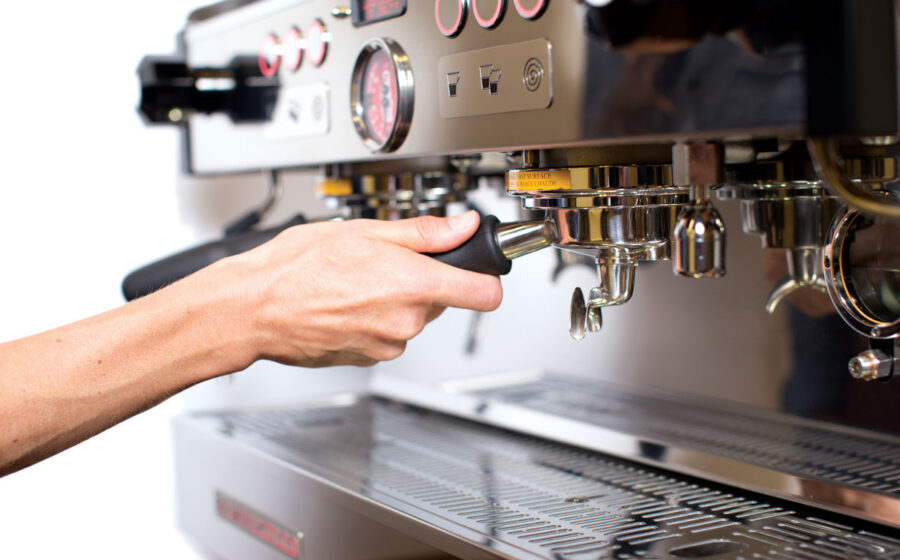[I]n August 2015, Fresh Cup published a suite of articles looking at safety and ergonomics behind the bar. The goal was to educate current and future retailers on setting up a safe space for their staff and helping baristas mitigate injury.
We recently republished one of those pieces on common cafe injuries. Today, we’ll look at barista wellness. Though most agree that being a barista requires refining highly-specialized skills, there remains uncertainty about the long-term impact of barista work on the body. Working behind the bar is physically taxing in subtle and not-so-subtle ways.
“I broke my wrist tamping,” says Alexandra LittleJohn. “I was nineteen, and I was tamping too hard and lost control of the portafilter and shattered my wrist on the countertop.” LittleJohn, who has worked in coffee for the last fifteen years, is the national sales manager for Equator Coffees & Teas and has a lot to say on the risks of working in a cafe.
“There are a lot,” she says. Her wrist has long since healed, but she still takes proper form seriously when training new baristas. Today, most trainers are at least aware of educating trainees on good wrist positioning, but that wasn’t always the case.
“The biggest issue for baristas is tamping,” says Matt Barahura, manager of James Coffee Company in San Diego. “When done improperly, repetitive tamping can cause pain in the wrist and elbow and eventually lead to more serious repetitive motion injuries.” Barahura, like many baristas, has learned to tamp with his left arm so as not to overstress the right. But more important than that, he says, is day-one barista training.
“When training new baristas, I can’t stress the importance of ergonomic tamping enough,” he says. “Proper ergonomics should be taught from day one and talked about regularly to keep everyone fresh.”
Holding employees to ergonomics standards should be a no-brainer, and not just when it comes to tamping. But coffee grew up fast; OSHA standards, for example, while steadfast in most of the service industry, never really made it off the back burner in coffee and tea retail, at least not outside of corporate coffee life.
We don’t talk enough about barista safety. Instead, we speak obsessively about how to accurately extract flavor from coffee or the latest piece of equipment. Cafés are built out meticulously to facilitate customer happiness with a staggering level of detail. But imagine if we put that same detail-oriented attitude to predict potential problems for the staff that inhabits those beautiful shops.
Usually it is not, or it begins and ends with tamping. So, what can baristas, managers, and café owners do to protect those who so admirably steward coffee to the consumer?
1. Train
One could write a book on ergonomic espresso making. With access to so much information, trainers and managers should spend meaningful time with every barista ensuring they tamp smart by gripping the tamper like a doorknob or flashlight, not with a “tiger claw” or fingers wrapped towards the base of the tamper.
Trainers should also teach new baristas how to steam smart. “Good steaming doesn’t require a lot of wrist movement on the barista’s part,” says LittleJohn. The idea of “working smart” extends to every way we move: baristas should be informed how to lift and bend smart, for example (from the legs and as little as possible).

It’s one thing to be able to make tasty espresso. As a leader, if that’s your primary focus, your staff could be talented but out of commission soon with sore wrists and cricked necks.
2. Design for Wellness
There are many tiny ways to streamline a café to prioritize the safety of workers. But it’s important to consider big ergonomic decisions when building a cafe. Think about things like:
- Where to put fridges (under-counter fridges require more bending, counter or waist-height are more easily accessible)
- Where to put anti-fatigue mats (baristas stand for hours, which stresses the back and legs)
- Bar size (baristas shouldn’t have to exhaust themselves reaching, crouching, or moving between stations—everything for drink creation should be in arm’s reach)
- Counter height (Is your counter height appropriate for your taller baristas but not the shorter ones? Is there a healthy middle?)
- Acoustics
Don’t underestimate that last one; cafés are noisy. Be mindful of echoes: you don’t want music or every sound from your espresso machine ricocheting off the walls too loudly. Six hours of auditory chaos can strain a barista’s eardrums and nerves.
3. Communicate With Staff Regularly
Safety training is only the beginning of keeping staff healthy. As a leader, it’s just as vital to regularly check in with your team on safety issues as it is to dial in coffees. A few things to keep an open line of communication are:
- Recommending ergonomic footwear
- Checking in and sending people home if they are sick
- The severity of burns since they handle hot liquids all day (200-degree burns are no joke)
- Discouraging “flair” moves like throwing portafilters
Communication has to be a two-way street. Listen to staff and actively solicit feedback on how things are running and how they feel after a long shift. Communication is the best tool for keeping them—and your business—healthy and happy.
4. Encourage Job Rotation
Many baristas work in the same positions all day and utilize the same muscle groups repeatedly. Have staff rotate jobs to take a break from exhausting movements like tamping or lifting milk cartons.

LittleJohn recommends rotating baristas through tasks every two to three hours or halfway through their shift. Rotating jobs can help prevent espresso-making muscles, for example, from getting over-worked; or mitigate some of the emotional toll of working on a busy register.
No employee should carry the burden of any one task, and in fact, all roles should be accessible to all of your employees. If a heavy bucket of spent grounds can only be lifted by the barista who also rock climbs, the bucket is too big. Similarly, your all-star barista might be beloved by your regulars, but that shouldn’t obligate them to handle orders and talk to customers for the entire shift.
LittleJohn listed some “dream tools” they’d like to see for baristas. Lighter portafilters, automatic milk dispensers (more popular in Europe and Australia), and height-adjustable espresso stations were just some of the things on that list. If the upswing in ergonomic tampers, espresso machines, and steaming equipment is any indication, our industry may be headed in that direction.
Some of your baristas might be working in coffee while they finish school, and others might be competition baristas or aspiring roasters. Regardless of their trajectory, trainers and managers do them a disservice by not considering the latent physical effects of their jobs.
At the very least, the risk of working behind the bar is better understood than ever before. The Occupational Safety and Health Administration (OSHA) has a set of restaurant standards, which is a great place to begin your education (and go over issues we haven’t here that can come up in cafés, like how to handle a knife). Ultimately, however, it is coffee bar veterans who know the most about what can go wrong. As career baristas get older and their muscles fight back, we’re continuing to recognize how vital it is to protect one’s body—and how necessary concrete steps to combat bodily wear and tear are for any café.
Photos by Cory Eldridge. Written by Regan Crisp.
This article was originally published on October 12, 2015 and has been updated to reflect Fresh Cup’s current editorial standards.

















